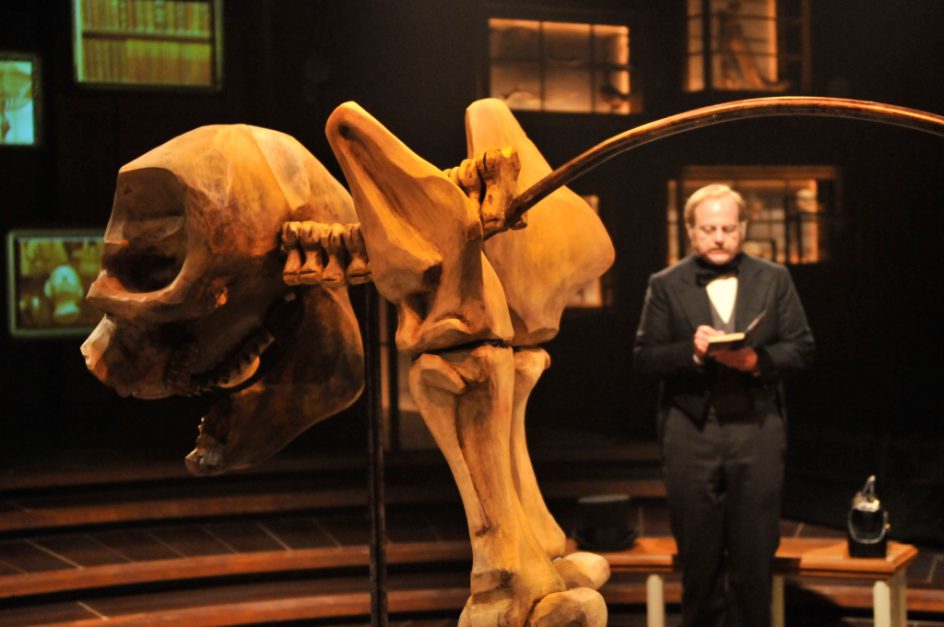Styrofoam has become one of the go-to substrates for creating scenic elements on stage, in themed environments and even in museum installations because it is light-weight, inexpensive and readily available. However, there are three major downsides to using foam: it’s fragile, it’s not flame retardant and it soaks up paint like a sponge. Rosco created FoamCoat almost 20 years ago to solve all three of these issues so that scenic artists and fabricators around the globe could texture, paint and protect their foam creations.
This Spectrum post shares the story of Haley Polak, a props artisan at the Alley Theatre. Haley sent us some photos illustrating how she used Rosco FoamCoat to create a large mastodon skeleton for the Alley’s world premiere of Elizabeth Egloff’s play Ether Dome.
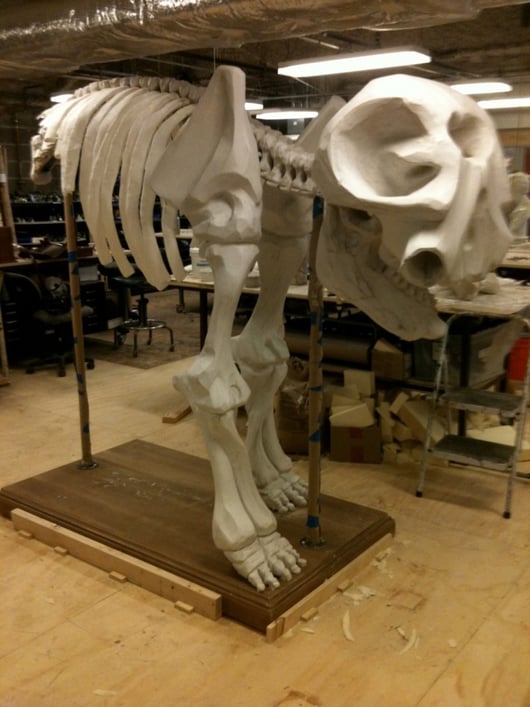 Stronger than a mastodon’s cranium! The skeleton with its first coat of FoamCoat.
Stronger than a mastodon’s cranium! The skeleton with its first coat of FoamCoat.
Strengthen From Within
Haley carved the leg bones, skull, and vertebrae separately out of rigid urethane foam and then applied them to a steel and wooden structure (the ribs were cast from another material). Haley chose to protect her large skeletal prop with FoamCoat because other techniques obliterated the features she painstakingly created in the carving process. The first coat of FoamCoat that she applied was diluted heavily with water. The absorbent foam soaked in the watery mix and the FoamCoat filled in the areas in-between the cells of the foam’s interior – making the foam stronger from the inside as well as adding a protective shell to the exterior.
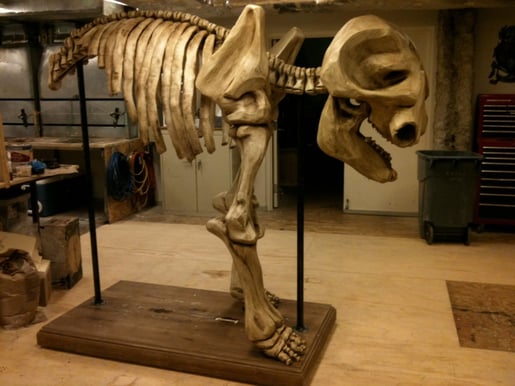 Haley was able to preserve the details she carved in the foam thanks to Rosco FoamCoat.
Haley was able to preserve the details she carved in the foam thanks to Rosco FoamCoat.
Tone and Texture
The second coat of FoamCoat on the mastodon was straight from the bucket and went on thicker using a chip brush. After the FoamCoat had a chance to set up a bit, but before it was completely dry, Haley was able to use different tools to mold, shape and stipple the product to create the various textures she desired on the bones. She also sanded some of the areas coated with FoamCoat to achieve an ultra-smooth finish – a feat that other protective techniques cannot achieve. Now that all of the porous foam was thoroughly covered in FoamCoat, Haley had a textured skeleton that was ready for painting. She used a blend of Rosco Off Broadway Scenic Paints including: Burnt Umber, Raw Sienna and Raw Umber to layer in the base-coat with highlight and shadow colors that accentuated the textures she created on the bones.
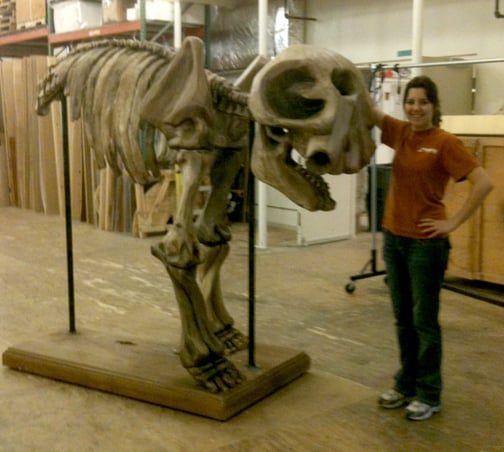 Haley Polak posing with her completed mastodon skeleton.
Haley Polak posing with her completed mastodon skeleton.
Accessorizing Afterward
Once it’s dry, FoamCoat’s slurry of polyester strands creates a durable, rigid, flame retardant coating; however, it is also pliable enough to allow a nail or tack to puncture its surface without cracking. This feature is especially useful to attach accessories to a coated piece or assemble an array of coated elements, such as dinosaur bones, together to form a larger structure. Plus, simply by adding another layer of FoamCoat, you can blend the seams into one homogenous piece.
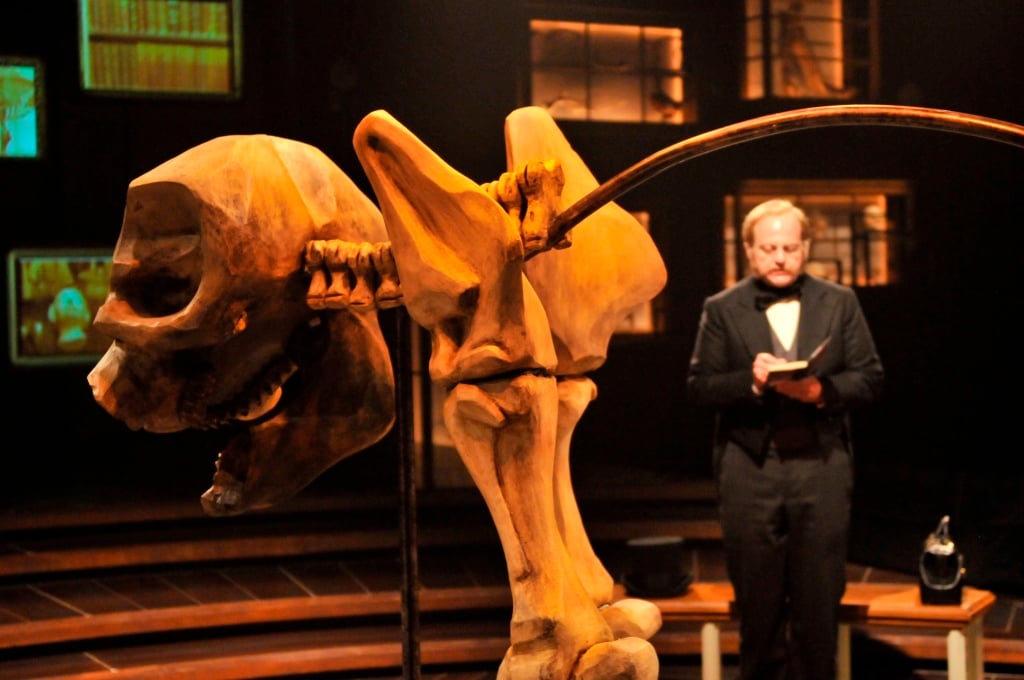 Jeffrey Bean in the Alley Theatre’s 2011 production of “Ether Dome.” Photo by Jann Whaley.
Jeffrey Bean in the Alley Theatre’s 2011 production of “Ether Dome.” Photo by Jann Whaley.
Share Your Work
If you have a project that showcases a Rosco paint or scenic product, share it with us like Haley did! Upload your photos, and the story behind them, to our Scenic Share-the-Work Page and we may end up featuring your project in an upcoming Spectrum post.
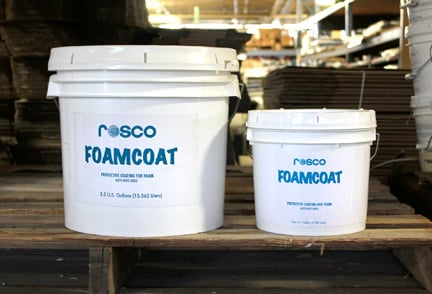 Rosco FoamCoat is available in single and 3.5 gallon containers.
Rosco FoamCoat is available in single and 3.5 gallon containers.
My favorite part of Haley’s story is the fact that her first experience with FoamCoat came from a 2oz sample jar that she received at our USITT booth. Those sample jars are still available for you to experiment with before your next project. Visit www.rosco.com and click Where to Buy to find a local Rosco dealer that can send you a sample jar of FoamCoat. Then, see for yourself how using Rosco FoamCoat will ensure your foam creations won’t go extinct during the run of the show.

